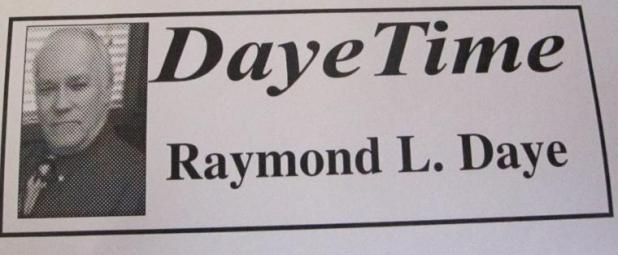
DayeTime: First comes Census, then reapportionment
This year is a Census year. It is important that everyone participate and answer the questions truthfully.
The Census not only determines how many congressmen the state has -- we’ve lost two since I started voting in 1974 -- but also helps determine federal funding. The information provided in the decennial survey also determines a community’s eligibility for federal programs and grants.
There are conspiracy theorists who believe the federal government is an evil organization that will, somehow, use generic demographic information to turn us all into mindless zombies.
Why would the government want to do that? I guess because it’s an evil organization, that’s why.
The most important question in the Census, of course, is how many people live in the household. The next most important will be the household income. After that, the information is more for statistical analysts and other wonks who enjoy crunching numbers. Those facts do give us and others a good snapshot of who we are and where we came from.
Now that I’ve got that “public service announcement” part of the issue out of the way, let’s talk about what comes after the Census numbers are “crunched.”
It is one of the longest “four-letter words” in the politicians’ dictionary: REAPPORTIONMENT.
I expect there will be a lot said about this a year from now. It is definitely too early to start drawing new election district lines because the population numbers haven’t been determined. However, it is the right time to start thinking about “big picture” issues that may be addressed when it comes time to draw those lines.
First, there is at least one municipality that currently has no district lines that probably should seriously consider joining the ranks of municipalities with single-member districts.
That town is Mansura.
Mansura is currently served by five aldermen elected at large. That means all voters vote for five candidates and the top five vote-getters are elected. Mansura is governed under the state Lawrason Act, which allows for at large elections or single-member districts.
Bunkie, Cottonport and Simmesport are Lawrason towns with single-member districts. Under that state law, the towns have four single-member districts and one alderman elected at large.
Marksville has five single-member districts because it is governed by a City Charter.
The parish’s four villages all have at large aldermen -- Moreauville, Hessmer and Plaucheville with three, as mandated by Lawrason, and Evergreen with five, as dictated by its Municipal Charter.
If Mansura were to decide to shed the at-large system for a single-member plan, it would have four districts and an at-large alderman that would serve as mayor if the mayor was absent.
If a community is, shall we say, not very diverse, then at-large elections are the best way to select your local leaders. You will have several elected officials who have to listen to you instead of just one.
However, in a diverse community, the group in the minority could find themselves with NO ONE who needs to listen to them in local government.
For example, let’s say there are 1,000 voters. Of that number, 700 look pretty much the same and the other 300 look similar to each other. There are five town council seats to be decided in the at large election. Five members of Group 1 qualify for the election and three members of Group 2 seek office. There is a risk that the “birds of a feather” rule could kick in on election day and all five council members would come from Group 1.
Even if every member in Group 2 chose not to cast a vote for any candidate from Group 1, there could be enough “One-ers” to sweep the election.
There is a voting system in some areas of the country that allows voters to “plump” their vote by having the opportunity to cast more than one ballot for a candidate.
In the above scenario, the 300 Group 2 voters could cast one vote for each of the three candidates from their group and then use their remaining two at-large votes to support one or more of those -- or a favored Group 1 candidate.
That may be a bit “out of the box” for Avoyelles Parish.
Single-member districts is a much better, and easier, way to ensure a community’s diversity is reflected in local government.
Of course, the best thing that could happen would be that votes would be cast for the candidate that could best serve the public in that position, without regard to the “group” they come from.
The other two major local redistricting battles would be in the Police Jury and School Board. Depending on which areas gained population and which ones lost population, lines could be drawn that would combine incumbents into the same district.
When that happens, lines often meander to ensure the incumbents remain in their districts. In extreme cases, election district lines have been known to run down the center of a road -- not including the properties on each side of the road -- until it reaches a population center large enough to meet the demands for the district and then balloon out to gobble up as many residents as needed for the district.
I think I probably speak for a lot of voters who hope the Police Jury and the School Board will adopt the same districts this time. Both have nine members with three minority members. It shouldn’t be that hard.
One board cannot split Census tracts but the other can. I forget which is which. Surely the two elected boards can agree on a 9-member plan that doesn’t split Census tracts. One of them will have to, so why can’t the other one just take that one?
If two School Board members get lumped into the same district, one of them can run for Police Jury.
